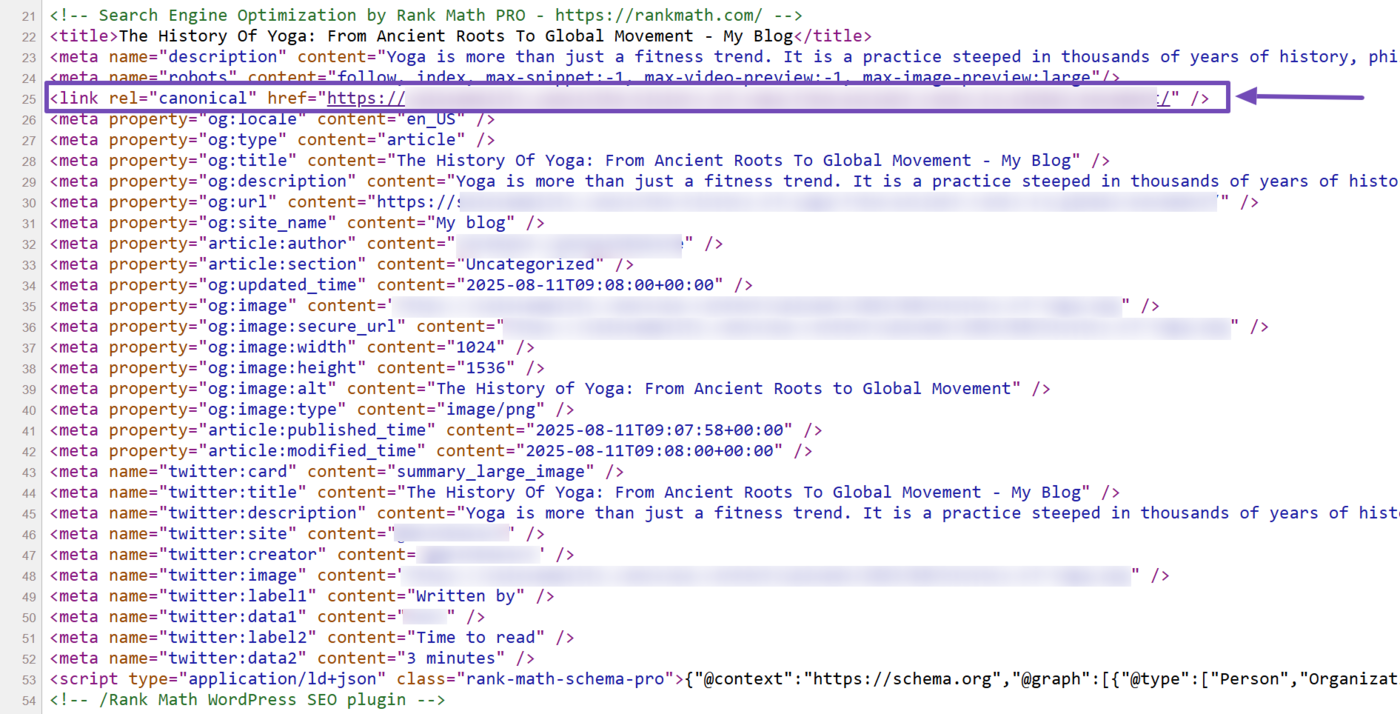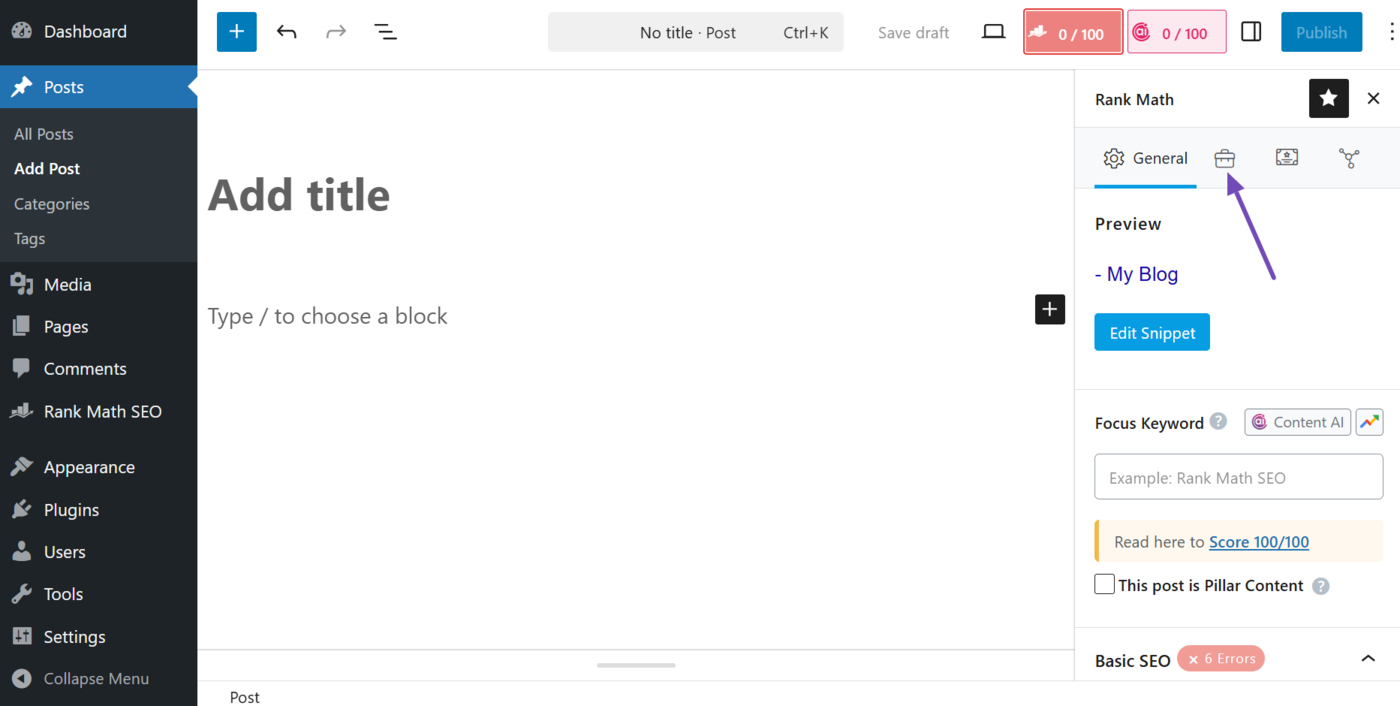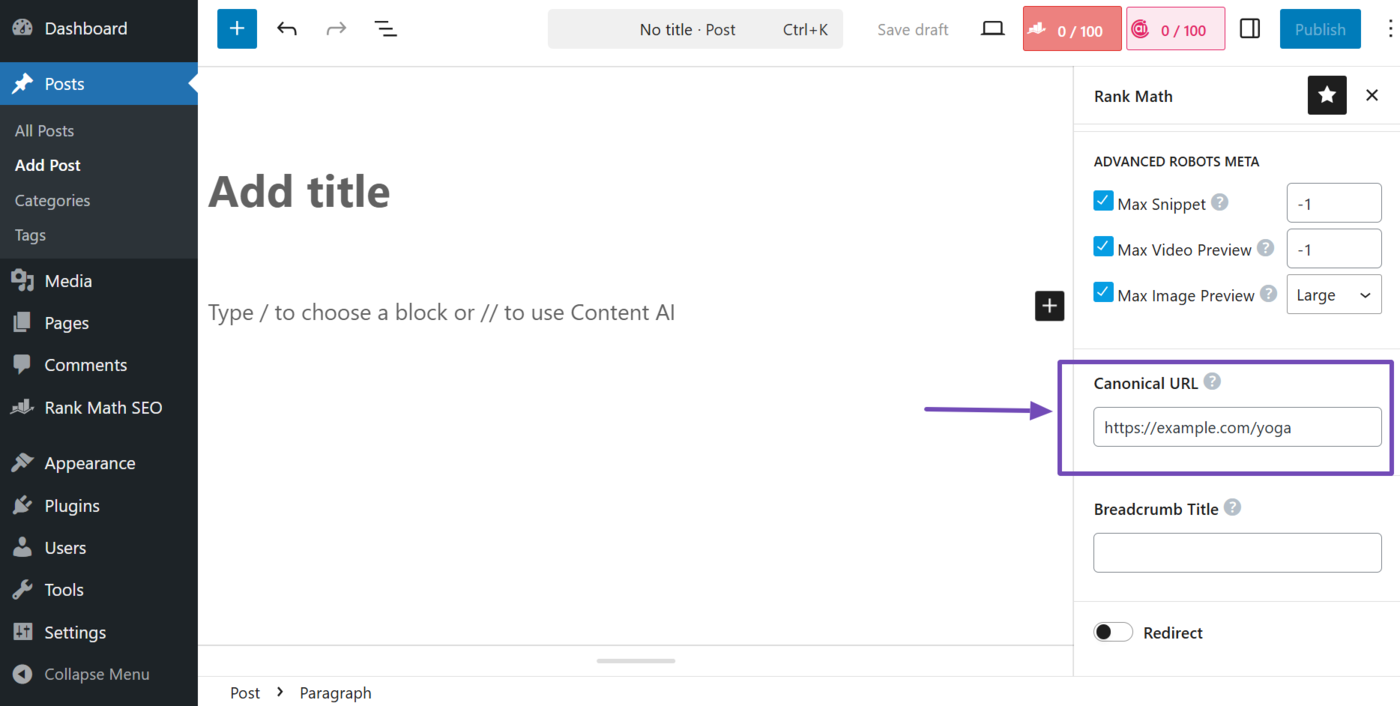What Is a Canonical URL?
A canonical URL is the preferred or original version of a webpage among a group of duplicate webpages. It is considered the main version, and visitors and search engines are directed to it instead of the duplicates.
Bloggers can specify a canonical URL by adding the canonical tag (rel="canonical") followed by the canonical URL. This tag has to the head (<head>) element of the HTML code on the main (canonical) and duplicate pages.
This is an example of the canonical tag and canonical URL that is added to the webpage’s code:
<link rel="canonical" href="https://example.com">
Each duplicate page should reference the canonical URL, while the canonical page can either reference itself or omit the tag.
This is what the canonical tag and URL code look like in a webpage’s HTML code:

In this article, we’ll cover:
Importance of Canonical URLs
Canonical URLs help search engines identify the version of a webpage that should be indexed and ranked among a group of duplicate pages.
This is crucial as search engines treat different URLs as distinct webpages, even when they lead to the same content. For example, you can have two URLs with the same content:
- https://example.com/yoga
- https://example.com/yoga/
While you may consider these URLs as the same webpage, search engines treat them as distinct webpages. Search engines do this because each URL can technically contain different content. So, they crawl and index them separately.
However, search engines also notice that the webpages contain the same content. So, they select one as the canonical (main) version and display it on search engine results pages.
Nonetheless, search engines may still display the non-canonical URL in some instances. This can happen when the non-canonical URL is optimized for specific devices or when the visitor uses search terms that indicate they want the non-canonical page.
Benefits of Canonical URLs
Canonical URLs provide search engines, bloggers, and their visitors with multiple benefits. We will now address them below.
1 Search Engines Can Prioritize URLs to Crawl
Search engines expend resources to crawl and index duplicate pages. However, since these pages contain the same content, this consumes resources that could be used to crawl and index more unique webpages.
Instead, search engines designate a single URL as the canonical version and prioritize it over the others. They will focus their efforts on the canonical URL and will crawl, index, and display it more often than the duplicates.
2 Bloggers Can Improve Their SEO
Canonical URLs allow bloggers to consolidate their SEO efforts on a single URL. This is crucial, as duplicate pages often split the ranking factors and signals that should ordinarily point to a single URL.
For instance, duplicate pages will typically split the バックリンク, リンクエクイティ、 と ページランク that would have gone to a single URL. The pages may also compete with one another for authority, impressions, and キーワード.
This will cause the duplicate pages to rank lower than they usually would. It can also lead to other issues, such as keyword cannibalization, in which multiple pages on a site compete for the same keyword.
3 Visitors Get a Better User Experience
The canonical URL ensures that visitors are directed to the most relevant, consistent, and authoritative version of a set of duplicate pages.
This improves the ユーザーエクスペリエンス for visitors, as they only get to see trustworthy sites in search results. It also ensures that visitors are not shown different webpages with the same content on a single search results page.
How to Specify a Canonical URL
You can easily specify your canonical URL using Rank Math. To get started, make sure to install Rank Math. Once done, open the relevant post or page from your WordPress dashboard.
Once you are on the post or page, click the Rank Math SEO 下図のようなアイコンが表示されます。
次に、 Advanced tab icon.
Now, scroll down to the Canonical URL field and enter your canonical URL into it. Once done, publish or update the page.
How Google Chooses Your Canonical URL
While you can specify a canonical URL, it is noteworthy to know that Google can choose a different URL as canonical. This happens because Google treats the canonical URL you set as a suggestion rather than a directive.
In other words, Google reviews multiple signals, including the URL you set as canonical, before deciding on which URL to choose as canonical.
The signals that Google uses to determine your canonical URL include:
- The URL in your サイトマップ
- The URL you set as canonical
- The URL you use in your internal links
- The URL your 301 permanent redirects point to
Overall, to increase the chances that Google sets your canonical URL as the canonical, make sure to include that same URL in your sitemap and internal links. Your 301 permanent redirects should also point to the canonical URL.
That way, Google is assured that the canonical URL is really the main webpage while the rest are duplicates.
However, it is important to know that a canonical URL is not restricted to your domain. If two sites publish the same or similar content, then Google will have to select one of the two webpages as canonical.
This can happen when a site republishes content that has already been published elsewhere under a content syndication agreement. It can also occur when a site copies content that has already been published on another site.
You cannot do much about a site that illegally copied your content, but Google does a good job at identifying the real owner of such content. However, as for syndicated content, ensure the other site includes a canonical URL pointing to your URL.
Some Canonical URL Best Practices
Canonical URLs can affect your SEO. To ensure they help rather than harm your rankings, make sure to follow the best practices below.
1 Only Use Absolute URLs
Always use the full (absolute) URLs in your canonical tags. This means your canonical tag should contain the protocol https:// followed by your domain name and every other URL slug that follows.
If your canonical URL ends in a forward slash /, then make sure to include it. For example, https://example.com/bets-yoga-poses.
Using absolute URLs ensures your canonical URL remains clear to search engines and prevents confusion.
2 Always Use One Canonical URL
Each webpage should only contain one canonical URL. All your duplicate webpages should also point to the same canonical URL. This ensures clarity and consistency, and avoids conflicting signals that can confuse search engines.
3 Use Self-Referencing Canonical Tags
The term “self-referencing canonical tag” refers to a canonical URL that points to the exact same URL that it is on.
For example, if your canonical URL is https://example.com, then every duplicate webpage, including https://example.com itself, should include a canonical tag pointing to https://example.com.
Including a canonical tag even when it points to itself is crucial, as it assures search engines that the webpage is the preferred version even when no duplicates exist.
4 Include Your Canonical URLs in Various Locations
Google uses multiple signals to determine which URLs to consider as canonical. So, you should make sure that the URLs specified at those signals are the same ones you set as your canonical URL.
Specifically, the URLs you include in your sitemap and use in your internal links and 301 permanent redirects should be the same ones you want Google to consider as canonical.
This sends a strong signal to search engines about which pages you want them to consider as canonical. It also prevents conflicting information between the different site signals.
5 Use the HTTPS Version as Your Canonical URL
Search engines prioritize 翻訳 websites over their HTTP counterparts. This means they are more likely to use the HTTPS version as the canonical version rather than the HTTP version.
This is why you should endeavor to use any of the HTTPS versions of the URL as your canonical URL. This increases the likelihood that Google will set that URL as the canonical.

